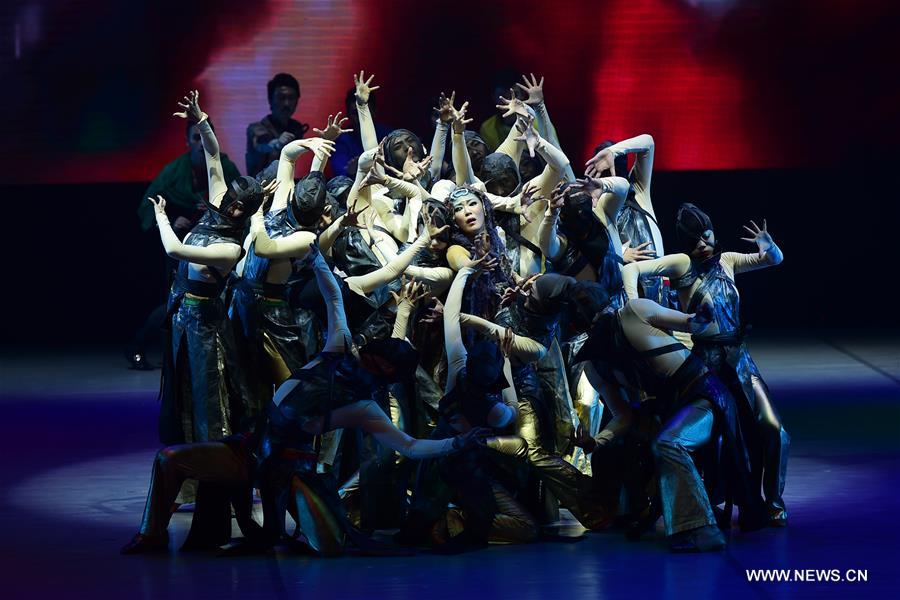Dance drama about China's Grand Canal stuns Egyptian audience
"My eyes and feelings were completely attached to the show, which took me on a magic carpet to taste the beauty of both history and modern life about China's Grand Canal," said Yaldiz Gamal, a lady in her 50th, as she watched the Chinese dance drama "To Meet the Grand Canal" in the Opera House of Cairo.
Dancers perform during a Chinese drama dance show named "To Meet the Grand Canal" in Cairo, Egypt on Nov. 28, 2017. [Photo/Xinhua]
"I'm a big fan of the ballet and drama dance shows, and the main common theme was always focusing on the men and women love stories or the struggle between good and bad in a direct way, but this is the first time for me to watch a very elegant performance, with highly professional dancers to defend a canal and tackle a tough environmental issue," Yaldiz told Xinhua.
"To Meet the Grand Canal," which is also scheduled to be performed at Alexandria Opera house on Thursday, is a synthetic presentation and expression of the cultural heritage of the Grand Canal of China.
The canal is the main artery that keeps Chinese nations prosperous. It links five major rivers system of China together, the Haihe River, the Yellow River, the Huaihe River, the Yangtze River and the Qiantang River.
"It is the most complicated and difficult piece I have ever created," said, Cui Wei, director of the dance drama show.
The toughest part was "no one can display the canal of thousands-year history in one hour and a half," the director wrote in the booklet distributed before the show has begun.
The Grand Canal, spanning over 2,000 kilometers between Beijing and Hangzhou was listed as a world heritage site in 2014.
The canal was a pillar of the economy, social stability and government function in ancient China, helping the evolution of Chinese culture by enhancing communication between the south and the north.
"For its length and historic importance, the canal was unlike scenery of Jiang Nan's stream and little bridge; It was a huge project. Therefore, we need collective work of creative artists and cultural preservers from different social regions and cultural identities to make a dance show as an homage to the canal and other world heritages," the director told Xinhua.
"Based on the common Grand Canal culture of the two countries, the tour to Egypt strengthened humanity exchanges and let both peoples feel proud of their splendid civilization. At the same time, they will allow young people of both countries to write a brand new future," Cui Wei told Xhinua.
Egypt's Suez Canal likewise the Chinese Grand Canal locates in the important areas along the line of the 21st Century Maritime Silk Road.
The show will be performed at Corinth canal of Greece as its second leg, then Erie of the United States, Panama Canal, Don-River Canal in Russia.
The Director added that "Meet the Grand Canal" will be in continuous conversation with the world canals to build a culture bridge for exchange with other countries.
"The story expresses love and respect for history and nature," said Mona, an 18-year-old student in the Cairo-Based Ballet Institute.
"When I saw the excavation work and the digging of the Grand Canal by the dancers, I remembered the pains that my grandfathers have experienced in building the Suez Canal," Mona added that mingling the history with love, dance and music was unbelievable and signaled how passionate and professional the director is.
The music, customs, colors, backgrounds of the canal, and movements of the dancers were a model for all ballet dancers to watch, learn from and enjoy, Mona added.
The show shed light on the hard work of excavating the canal, passing through prosperous years, then came the pollution which threatened the life of all beauty inside, or surrounding the canal. The last scene of the show brought back hope and happiness after the man-made waterway was cleaned and purified.
"Such a piece of particular significance should be more a cultural event rather than such a dance drama," said Menna, another ballet dancer, after watching the performance.
The young ballerina told Xinhua "it was my first time to watch Chinese show. I was confused at the beginning because I don't understand the language, but then the idea was crystal clear through dancing."
Despite the fact that the show was mainly about environment and pollution, she still saw it as an unforgettable piece of art at all levels.
"I learned today that the value of cultural heritage lies in its essence of being accomplished by people and nature together," she pointed out.
The music composition and the balanced synchronization of the dancers made her part of the history despite she belongs to modernity, Menna said.
"Combing tradition and modernity, history and future, nature and the big love, everyone can feel that the show is not merely meant to depict a canal but it mirrored development and integrity of the people for building and advancing their societies," the young girl expressed her feelings while making some simple ballet movements.
